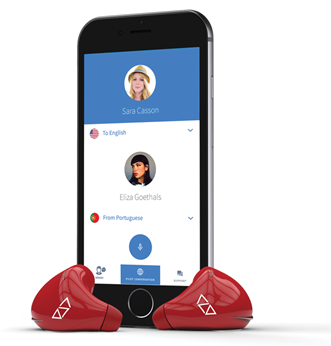Normally my objective for this column is to highlight an innovation that is already fully realised and on the market. Sometimes it can be fun instead to look forward to what innovations are coming down the pipeline. With that in mind, I’d like to take this opportunity to explore two innovations that I am hoping to see in the not too distant future. For more information about the products described and future release dates, please refer to the product websites.

Smart Cane: French company Nov’in has teamed up with the walking stick makers at Fayet to create the Smartcane, powered by Dring technology (http://dring.io/en/). An innovation winner at CES 2017, the Smartcane uses sensors embedded in the cane’s handle to learn the user’s usual movements and detect when something is off (e.g. a fall or continuous immobility). The cane will then automatically send a message (text, email, or phone call) to predetermined caregivers to alert them.
“Smartcane uses sensors embedded in the cane’s handle to learn the user’s usual movements and detect when something is off.”
An internal GPS system can also be used to provide caregivers with the user’s location. Once a caregiver confirms that they can assist, the handle will also alert the user that help is on the way. The cane can last for weeks without needing to be charged and does not need to be paired to a smartphone. Not everyone will see value in a device like this. However, those who are at risk of falls may welcome the peace of mind of knowing that others will be alerted if a fall takes place.

(Near) Real-Time Language Translation: The internet was abuzz in 2016 with the launch of an Indigogo campaign from Waverly labs. The product? The world’s first ‘smart earpiece’ designed for language translation, known as Pilot (www.waverlylabs.com). Using a combination of speech recognition, translation, and speech synthesis, Pilot is designed to facilitate conversation between speakers who do not speak the same language.
The speech signal is filtered, translated, and delivered to the Pilot wearer in his or her preferred language in near real time through a Bluetooth earpiece. The initial launch of Pilot will support five languages (English, French, Italian, Portuguese, and Spanish) with more to follow. While exciting in concept, Pilot has some key limitations that potential early-adopters should be aware of: Pilot is not immune to the problems with lag and accuracy that plague the other language translation apps already available on the market (e.g. Skype Translator).
“Pilot is designed to facilitate conversation between speakers who do not speak the same language.”
In addition, the first iteration of Pilot cannot translate everything in the environment and will instead require the conversation partner to also wear an earpiece (orders will ship with an extra earpiece), or else download the accompanying app. While Pilot may not yet be the game-changer everyone hoped it would be, it is certainly a promising step towards making language barriers a thing of the past. Once fully realised, this technology may have the capacity to improve the clinician-patient relationship when a language-barrier is present.



